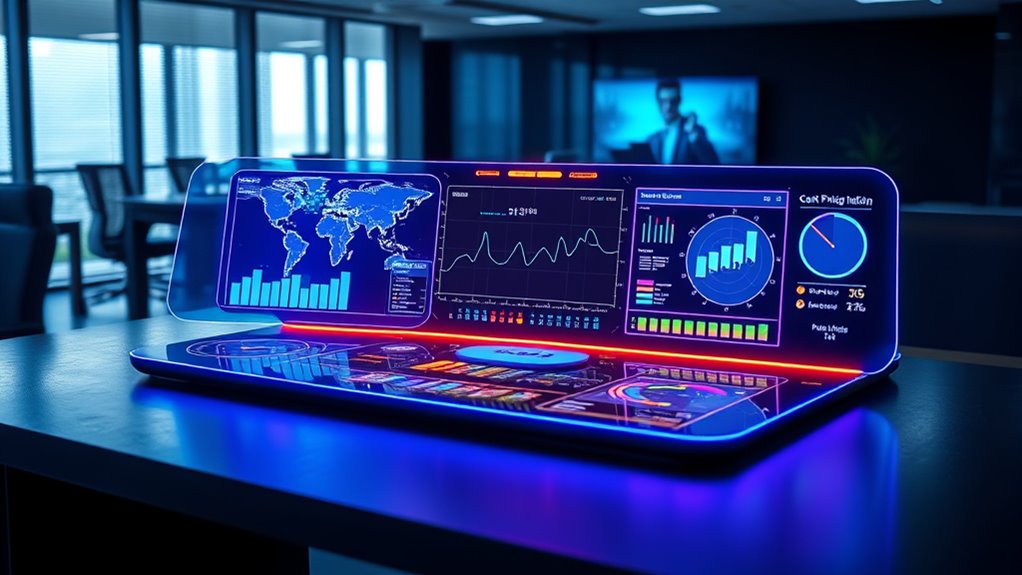Augmented reality dashboards put essential information right in your line of sight, blending virtual data seamlessly into your environment. They let you access real-time metrics, machine statuses, or crucial signs without shifting focus, keeping you engaged and more responsive. These interfaces respond to your gestures or voice, making interactions natural and efficient. As this technology advances, you’ll experience more immersive, customizable, and intuitive data displays. Explore further to discover how AR dashboards are shaping the future of interface design.
Key Takeaways
- AR dashboards overlay critical data directly onto the user’s field of view, enabling real-time, hands-free information access.
- They enhance user engagement through immersive, customizable interfaces that adapt to individual needs and environmental context.
- Virtual interfaces respond dynamically to user movements and inputs, providing swift, situational insights across various industries.
- Designed for clarity, AR dashboards display only essential information, reducing clutter and improving safety and efficiency.
- Continuous advancements aim for more natural, intuitive interactions, making data engagement seamless and more impactful.

Augmented reality dashboards are transforming how you interact with data by overlaying critical information directly onto your field of view. Instead of glancing at separate screens or devices, you now have a virtual interface that seamlessly integrates with your environment. This innovation allows you to access real-time data without breaking your focus, making decision-making faster and more intuitive. As you move through your workspace or operate machinery, the AR dashboard adapts to your perspective, presenting relevant metrics precisely where you need them. This creates a more natural flow of information, reducing cognitive load and streamlining your workflow.
The virtual interface built into augmented reality dashboards is designed to enhance user engagement by providing a more immersive experience. Unlike traditional dashboards that require you to shift attention to a screen, AR puts data directly in your line of sight, encouraging continuous interaction. You can manipulate information with simple gestures or voice commands, making the process feel more intuitive. This heightened engagement keeps you more connected to your tasks, helping you identify issues quicker and respond proactively. The immersive nature of AR dashboards fosters a sense of control, as you can customize what data appears and how it’s displayed, tailoring the experience to your specific needs.
With augmented reality dashboards, your interaction becomes more dynamic. You’re no longer confined to static displays; instead, the virtual interface responds to your movements and inputs in real-time. Whether you’re in manufacturing, logistics, or healthcare, this adaptability means you get the most relevant information exactly when you need it. For example, in a factory setting, you might see machine status updates overlaid on equipment, instantly recognizing when maintenance is needed. In a medical environment, AR dashboards can project vital signs or patient information directly into your view, allowing swift assessments without diverting your attention. This fluid interaction enhances user engagement by making data more accessible and easier to interpret.
Furthermore, the virtual interface’s design prioritizes clarity and usability. By overlaying only essential information and allowing customization, it prevents clutter and distraction. You can focus on critical metrics or alerts, reducing the chance of overlooking vital data. This precision improves your efficiency and safety, especially in high-stakes environments. The use of augmented reality in dashboards fundamentally shifts how you engage with data—moving from passive observation to active, immersive participation. As this technology advances, expect even more seamless integrations that heighten user engagement, making data interaction more natural and impactful than ever before. Additionally, integrating clarity and usability principles from the design of digital interfaces ensures that AR dashboards remain accessible and effective for all users.
Frequently Asked Questions
How Secure Are Augmented Reality Dashboards From Cyber Threats?
Augmented reality dashboards face cybersecurity challenges, but their security depends on robust measures like data encryption. You should guarantee that sensitive data transmitted through AR interfaces is encrypted to prevent interception. Regular updates and strong authentication protocols help protect against cyber threats. While AR dashboards offer new opportunities, staying vigilant and applying these security practices is essential to safeguard your information from potential cyber attacks.
What Hardware Is Required for Optimal AR Dashboard Performance?
To achieve peak performance on your AR dashboard, you’ll need hardware that includes a powerful processor, sufficient RAM, and a high-resolution display or AR headset. A dedicated graphics card improves visual rendering, while sensors and cameras ensure accurate environmental tracking. Good connectivity, like fast Wi-Fi or 5G, also enhances real-time data updates. Investing in quality hardware ensures smooth interactions, reduces lag, and provides a seamless AR experience.
Can AR Dashboards Be Integrated With Existing Enterprise Systems?
Yes, you can seamlessly synchronize systems and streamline data with augmented reality dashboards. By blending robust enterprise integration with real-time data synchronization, you enhance efficiency and elevate experiences. You’ll find that AR dashboards adapt easily to existing enterprise environments, empowering you to access accurate, up-to-date information effortlessly. This integration transforms traditional tasks into dynamic, data-driven displays, delivering a seamless, synchronized, and smart solution tailored to your enterprise needs.
How Do AR Dashboards Impact User Productivity and Decision-Making Speed?
AR dashboards boost your productivity and decision-making speed by enhancing user engagement and providing superior visual clarity. You can quickly interpret complex data through immersive visuals, reducing cognitive load. This allows you to make informed choices faster and with greater confidence. As you interact more naturally with real-time information, your ability to respond swiftly improves, streamlining workflows and enabling more efficient, data-driven decisions in dynamic environments.
What ARe the Costs Associated With Implementing AR Dashboard Technology?
You’ll face costs like high upfront investments in hardware and software, which can be significant. While AR dashboard implementation offers improved decision-making, it demands ongoing maintenance and updates. Cost analysis reveals that initial setup and training can strain your budget, but long-term gains in efficiency might offset these expenses. Budget considerations are essential to balance the technology’s benefits against its financial impact, ensuring your investment aligns with your organizational goals.
Conclusion
Imagine walking into a control room where data floats seamlessly around you, like a cockpit of a spaceship. That’s what augmented reality dashboards promise—an intuitive, immersive way to manage information. Just as a pilot relies on their instruments, you’ll effortlessly navigate complex data in real time. As AR tech advances, you’ll find yourself in a future where information isn’t just seen—it’s experienced, making decisions faster and more precise than ever before.









